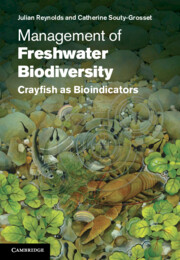Book contents
- Frontmatter
- Contents
- Preface
- Acknowledgements
- Introduction: Biodiversity in freshwater systems, and the key roles played by crayfish
- Part I The present situation of crayfish in world freshwater ecosystems
- Part II Applying science to conservation management
- A Protecting freshwater biodiversity through monitoring and conserving crayfish
- B Management for conservation
- 8 Control and management of non-indigenous crayfish
- 9 Biodiversity management through the reintroduction of heritage crayfish species
- Part III Knowledge transfer for successful crayfish management
- References
- Glossary
- Index
- Scientific and common English names of well-studied crayfish featured in this book
- Common English and scientific names of well-studied crayfish featured in this book
- Plate section
8 - Control and management of non-indigenous crayfish
from B - Management for conservation
Published online by Cambridge University Press: 05 December 2011
- Frontmatter
- Contents
- Preface
- Acknowledgements
- Introduction: Biodiversity in freshwater systems, and the key roles played by crayfish
- Part I The present situation of crayfish in world freshwater ecosystems
- Part II Applying science to conservation management
- A Protecting freshwater biodiversity through monitoring and conserving crayfish
- B Management for conservation
- 8 Control and management of non-indigenous crayfish
- 9 Biodiversity management through the reintroduction of heritage crayfish species
- Part III Knowledge transfer for successful crayfish management
- References
- Glossary
- Index
- Scientific and common English names of well-studied crayfish featured in this book
- Common English and scientific names of well-studied crayfish featured in this book
- Plate section
Summary
Background
Species that have been introduced outside their native range (alien or non-indigenous species) have the potential to cause irreparable ecological and economic damage. Although the proportion of introduced species that become invasive is usually relatively small (just 1% of those released and about 10% of survivors of translocation; according to the ‘ten percent rule’ for non-native species released into new ecosystems (Williamson & Fitter, 1996)), the significant risks that these few organisms pose require the adoption of precautionary approaches to prevent the deliberate or accidental introduction of potential invaders and to design contingency plans detailing the actions needed to rapidly mitigate and remediate their impacts (Manchester & Bullock, 2000). We will see that crayfish do not follow the 10% rule for invasive species, as a much larger percentage of crayfish introductions seem to thrive.
Hundreds of freshwater species have been moved outside their native ranges by vectors such as ballast water, canals, deliberate introductions, and releases from aquaria, garden ponds and bait buckets. Some invaders have had profound effects on the ecosystems that they invade. Classes of ecologically important invaders in fresh waters include molluscs that are primary consumers and disrupt the food web from its base, fishes that disrupt the food web from its apex or centre, decapods that act as powerful omnivores, aquatic plants that have strong engineering effects and affect the quality and quantity of primary production, and diseases, which have probably been underestimated as an ecological force (Strayer, 2010). Interactions between alien species and other contemporary stressors of freshwater ecosystems are important and varied. Because disturbance is generally thought to favour invasive species, stressed ecosystems may be especially susceptible to invasions, as are highly artificial ecosystems. In turn, alien species can strongly alter the hydrology, biogeochemical cycling and biotic composition of the invaded ecosystems, and thus modulate the effects of other stressors.
- Type
- Chapter
- Information
- Management of Freshwater BiodiversityCrayfish as Bioindicators, pp. 197 - 218Publisher: Cambridge University PressPrint publication year: 2011
- 1
- Cited by



